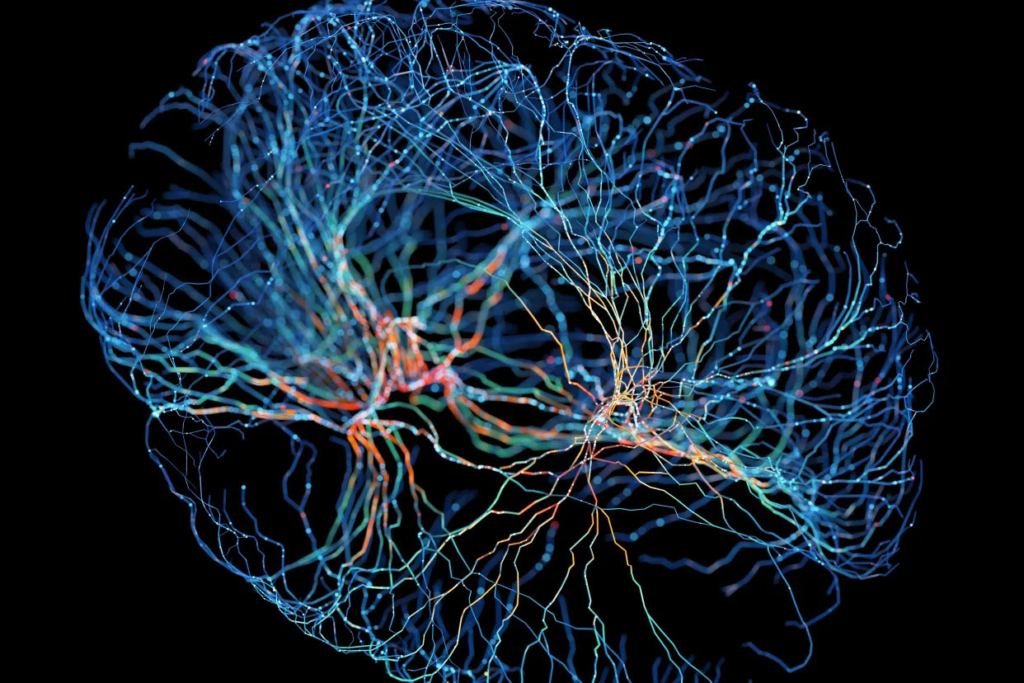Veronique Greenwood
Updated Sat, October 21, 2023 at 9:04 AM MST

System of neurons with glowing connections on black background (Andriy Onufriyenko via Getty Images)
Some years ago, scientists in Switzerland found a way to make people hallucinate. They didn’t use LSD or sensory deprivation chambers. Instead, they sat people in a chair and asked them to push a button that, a fraction of a second later, caused a rod to gently press their back. After a few rounds, the volunteers got the creeping sense of someone behind them. Faced with a disconnect between their actions and their sensations, their minds conjured another explanation: a separate presence in the room.
In a new study published in the journal Psychological Medicine, researchers from the same lab used the ghostly finger setup to probe another kind of hallucination: hearing voices. They found that volunteers were more likely to report hearing a voice when there was a lag between the push of the button and the rod’s touch than when there was no delay.
Sign up for The Morning newsletter from the New York Times
The findings suggest that the neurological roots of hallucinations lie in how the brain processes contradictory signals from the environment, the researchers said.
Hearing voices is more common than you might think, said Pavo Orepic, a postdoctoral researcher at the University of Geneva and an author of the new paper. In surveys, scientists have discovered that many people without a psychiatric diagnosis — perhaps 5% to 10% of the general population — report having heard a disembodied voice at some point in their lives.
“There is actually a continuum of these experiences,” Orepic said. “So all of us hallucinate — at certain times, like if you’re tired, you’ll hallucinate more, for instance — and some people are more prone to do so.”
In the new study, as in earlier work, Orepic and his collaborators had volunteers sit in a chair and push the button that caused the rod to touch their backs. During some sessions, there was no delay between the push and the touch, while others had a half-second delay — enough time to give volunteers that feeling that someone was nearby.
During all trials, the volunteers listened to recordings of pink noise, a softer version of white noise. Some recordings contained recorded bits of their own voice, while others had fragments of someone else’s voice or no voice at all. In each trial, the volunteers were asked if they had heard anyone speaking.
The study found that when people were already experiencing the peculiar feeling of a ghostly presence, they were more likely to say they had heard a voice when there was none. What’s more, hearing a nonexistent voice was more likely if, earlier in the experiment, they had heard bursts of noise with someone else’s voice in them.
That suggests the brain was linking the hallucinated presence and the voice, Orepic said.
Intriguingly, volunteers with no lag between the button-pressing and the rod sometimes reported hearing a nonexistent voice as well, and they were more likely to do so if they had recently been hearing clips of their own voice. If volunteers unconsciously decided they were responsible for the feeling of the finger on their backs, they may have been primed to hear their own voice, the researchers said.
Together, the findings support the idea that hallucinations may arise from difficulty in recognizing one’s own actions, as well as being primed to expect a particular outcome, Orepic said. As time went on, people experiencing a ghostly presence in the trial were increasingly likely to hear voices, implying that the brain was somehow drawing on past experience to build up the impression of someone speaking.
Delving more into how the brain builds the impression of a voice when none is there, Orepic said, may rely on help from healthy people who regularly hear voices — for instance, mediums who feel they can communicate with the dead. He points to ongoing studies at Yale with such people who hear voices as a pathway to understanding how these beliefs arise and how they may be controlled. For mediums, hearing voices is not necessarily unwelcome. But perhaps, with their aid, people whose hallucinations are distressing and disruptive may find some peace.
c.2023 The New York Times Company

Leave a Reply